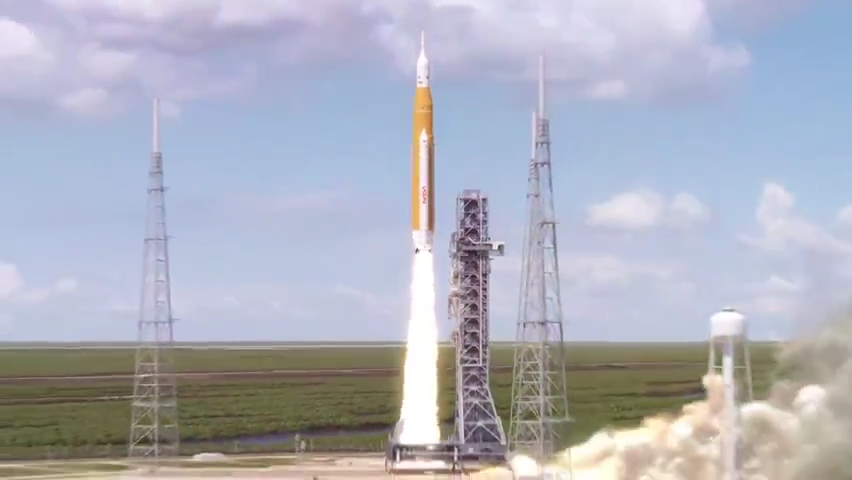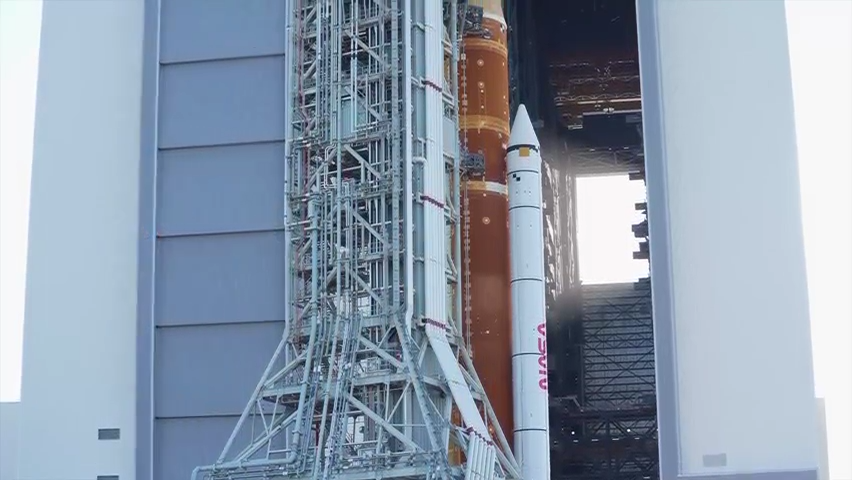
Artemis I NASA’s plans to travel beyond the moon
Artemis 1 will be the first integrated test of NASA’s deep space exploration systems: the Orion spacecraft, Space Launch System (SLS) rocket and the ground systems at Kennedy Space Center.
NASA
Space is important to us and that’s why we're working to bring you top coverage of the industry and Florida launches. Journalism like this takes time and resources. Please support it with a subscription here.
---
As NASA pushes toward a third attempt at launching the Artemis I mission later this month, the agency's use of a popular rocket propellant – supercooled liquid hydrogen – has become the center of attention due to its finicky nature.
Now set for liftoff no earlier than 6:47 a.m. EDT Friday, Sept. 23, the 322-foot Space Launch System rocket's ground support equipment is under repair at Kennedy Space Center. Two previous attempts at launching an uncrewed Orion capsule to the moon were scrubbed due to hydrogen-related cooling and fueling issues.
Teams at pad 39B are currently investigating what caused a serious hydrogen leak during the fueling process on Sept. 3. The massive rocket's liquid oxygen tank reached 100% filled, but hydrogen only hit 11% during the countdown, forcing teams to scrub and investigate the issue contained to a quick-disconnect, or QD.
Frequent issues with hydrogen, many of which trace back to the space shuttle program, are common. That it requires more cooling – liquid hydrogen must be stored at minus 423 degrees Fahrenheit – compared to other propellants ultimately means embrittlement, or the weakening of components like metal storage tanks, tends to be the primary driver of hardware issues. It also must be pumped in at high pressures, easily exposing even the smallest leaks.
On the plus side, though, hydrogen provides more performance than other rocket fuels.
More: NASA retargets late September for Artemis I launch as teams work hardware
NASA's huge Artemis launch: It's going to be loud, but how loud? That depends
"Certainly there's no question that hydrogen is a challenging molecule, but it's worth it," John Blevins, NASA's chief SLS engineer, said during a post-scrub briefing this week. "Hydrogen is the highest-performance molecule and if you look at the mission we're doing, it begs the use of this fuel."
"It wants that sustained, high performance that you get out of what is really the most high-performing rocket engine on the planet: that is the (four RS-25 main engines)," Blevins said.
Artemis I is part of NASA's overall program to take astronauts back to the moon. If everything goes well with this uncrewed test flight, astronauts are expected to fly a similar there-and-back mission known as Artemis II sometime after 2024. NASA hopes to put two people on the surface before 2030, then establish a permanent presence before moving on to Mars.
FLORIDA TODAY spoke with Jim Brenner, an associate professor of chemical engineering at Florida Tech with extensive experience in hydrogen, about rocket propellants and how they compare.
Note: This Q&A has been edited for length and clarity.
FLORIDA TODAY: Kerosene, methane, and hydrogen are some of the most popular rocket propellants today. Can you offer a brief overview on how they rank?
Brenner: Kerosene has a lower density – that’s probably the best way to put it – than methane, and hydrogen has the highest of the three.
But as you go from kerosene to methane to hydrogen, the boiling point is going to go down considerably. That means to keep it as a liquid, and you need to do that to minimize the amount of space taken up on the rocket, you’ve got to go much, much colder. And the colder you go, the more likely you are to embrittle the container that you’re putting it in.
Differences in temperature
FT: At that point, you're probably also contending with fluctuations in temperature, right? Like the difference in temperatures between these cryogenic propellants, hardware that's been warmed up by the warm Florida air, and so on?
Brenner: That is a factor. Certainly temperature variations both within the day and between when a tank is full versus when it's not, do have their effects.
Going back to the first two space shuttle disasters, both of those were caused by thermal expansion-related problems. For the second space shuttle disaster (Columbia in 2003), the conclusion from one of the dissertations that I was part of here was that the polymer foam on the outside of the space shuttle should have been replaced ... and it ultimately caused the second disaster. That really is probably the best example that the general public would be able to remember of what I call cryogenic embrittlement. When you get down to a sufficiently low temperature, even metal is going to become brittle.
Hydrogen is also different from some materials in that it will make the metal brittle independent of the temperature (a well-documented phenomenon caused by metals absorbing hydrogen). So you can have embrittlement issues at any temperature with hydrogen, but they're obviously much worse at lower temperatures.
Hydrogen's performance
FT: When it comes to Artemis I and the Space Launch System, NASA officials say hydrogen is needed for performance. So of the three popular propellants mentioned, hydrogen has the highest performance once it's in use?
Brenner: That is correct. And that's why hydrogen has always been the preferred fuel for that.
If you are not interested in reusability (like SLS since it will be expended after launch), then it probably is the best choice. But if you're going to reuse things, then you have to make sure after each fill and empty that the cryogenic embrittlement and cyclic fatigue associated with repeated use isn't going to cause a cumulative effect that makes problems similar to what they're experiencing with Artemis.
There are only so many times you can cool things down to that low of a temperature before you are eventually going to have problems. While Artemis has had problems like this, it's far from the first time the space business has had this problem. They've had problems with liquid hydrogen and liquid oxygen for a long time.
Kerosene's popularity in reusability
FT: So looking at something like SpaceX's Falcon 9 rocket, is the difference between kerosene and hydrogen so great that SpaceX is able to fly over and over again without as many issues?
Brenner: That certainly is the working premise. I couldn't tell you how many cycles it's going to be able to last, but that is why they're going that route.
Because it's not getting as cold, you're not going to have as many problems as you would with liquid hydrogen. Their premise is a reasonable one.
Hydrogen as the most abundant element
More: Artemis I spectators swarm Space Coast but launch attempt scrubbed
FT: When discussing hydrogen as fuel, you're bound to hear about how it must be a logical choice since it's the most abundant element in the universe – and how it could someday be produced on the moon before missions to Mars. Is there any practical truth to that?
Brenner: You can't mine hydrogen on the moon. If we're going to have a space vehicle come back from either the moon or Mars, we're either going to have to send a vehicle up with the fuel to come back – economically, that's a loser – or we're going to have to mine the necessary resources for a propellant to get us back.
There are plenty of people who are looking at mining aluminum from the moon or Mars, forming that into nanoparticles, and using that as a propellant. That's frankly quite dangerous because you're quite literally trying to store an explosive.
Hydrogen also isn't at a high enough concentration to be able to practically do much with it. Yes, it's the most abundant thing in the universe, but it's not in a form that you can easily use. Water here on Earth is pretty easy to use because it's in a liquid form, but trying to concentrate something that's in the gas phase so that it's easy to store makes a big difference.
That's why kerosene, or gasoline or diesel for that matter, are better for terrestrial vehicles than natural gas or hydrogen. Yes, you can run vehicles off natural gas or hydrogen here on Earth, too. But when you do that, you've either got to cool them down to a very low temperature or you've got to pressurize them to a very high pressure – and often both. That's just not as easy to do as it sounds on paper.
SpaceX using methane for Starship

Artemis | Five facts about the Space Launch System rocket
Five facts you should know about the Space Launch System rocket.
Rob Landers, Florida Today
FT: How does SpaceX's Starship system – also massive in size and being developed for deep space – and its use of methane fit into this?
Brenner: Methane is kind of in between kerosene and hydrogen. It's not as dense of an energy source, but you don't have to cool it down as much as hydrogen, so you're not going to have as many problems with reusability as you would with hydrogen.
A lack of materials data
FT: You mentioned that one of the reasons we're seeing these issues is the lack of data and experience. Can you expand on that?
Brenner: There's really not that much data out in the public domain on the reliability of materials at the kinds of conditions that we abuse our materials at in East Central Florida. No place in the world abuses our materials like we do here.
The rocket business is a very unforgiving environment. We take materials up to very high temperatures and to very low temperatures and there just isn't a lot of materials reliability data under the conditions that we're talking about.
Until somebody develops a database that is in the public domain on materials reliability under these sorts of conditions, you're going to have problems like what Artemis is having. You can't look that sort of stuff up on the internet – it's just not there.
We can't afford to have another space disaster. If somebody has a problem with a materials reliability issue and it was an FIT person responsible, I was probably the person who taught that student. It's important that I make sure they're doing things as safely as reasonable.
It's not very easy because we don't really have the appropriate data at this point to be able to predict these things as well as we ought to.
Contact Emre Kelly at aekelly@floridatoday.com or 321-242-3715. Follow him on Twitter, Facebook and Instagram at @EmreKelly.
Current Launch Windows for Artemis I
Friday, September 23:
- Launch time: 6:47 a.m. EDT
- Launch window: 120 minutes
- Orion splashdown: Oct. 18
Tuesday, September 27:
- Launch time: 11:37 a.m. EDT
- Launch window: 70 minutes
- Orion splashdown: Nov. 5
Visit floridatoday.com/space three hours before each window opening for live video and real-time updates.
https://news.google.com/__i/rss/rd/articles/CBMigwFodHRwczovL3d3dy5mbG9yaWRhdG9kYXkuY29tL3N0b3J5L3RlY2gvc2NpZW5jZS9zcGFjZS8yMDIyLzA5LzEwL2FydGVtaXMtbWlzc2lvbi1oYXJkLW1hbmFnZS1oeWRyb2dlbi1uYXNhcy1mdWVsLWNob2ljZS84MDE0NTMzMDAxL9IBAA?oc=5
2022-09-11 00:21:28Z
CAIiEO-Cgvqn835hrxAcmkc8RacqGQgEKhAIACoHCAowjsP_CjD2kPkCMMzt5wU

Tidak ada komentar:
Posting Komentar